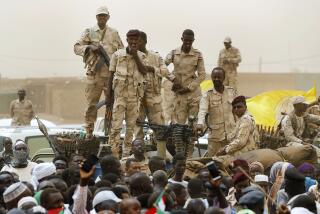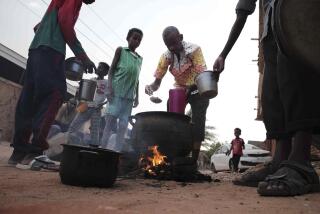Sudanese Rebel Who Made Peace Dies
GOMA, Congo — John Garang, a charismatic southern Sudanese rebel who led a 20-year fight against the government only to make peace with it and join a new coalition government last month, was killed in a helicopter crash over the weekend, Sudan’s government said early today.
Garang was returning from Uganda on Saturday after meeting with the president there when his aircraft went down in rugged terrain in southern Sudan.
“The march of peace will continue toward its goal, and his death will only make us stronger and more determined to complete the march which he began and his companions began,” said a statement from Sudan’s presidency read on state television. Six of Garang’s colleagues and seven crew members also died in the crash, the government said.
The death of the 60-year-old Sudan People’s Liberation Movement leader is expected to deal a serious blow to Sudan’s peace process. Garang was the driving force in a peace agreement signed this year between the largely Christian and animist south and Muslim Arab leaders in the north, ending a war that claimed at least 2 million lives.
As part of that deal, Garang was appointed July 9 as first vice president of Sudan and president of a semiautonomous region in the south. More than 1 million people lined the streets of Khartoum, the capital, to greet him.
“This is going to throw the peace process into utter chaos,” said Robert Collins, a former UC Santa Barbara professor and a Sudan scholar. “Garang’s presence as the link to the north was absolutely essential.”
Collins noted that Garang was a firm believer in keeping Sudan united, whereas many other rebel leaders and southerners preferred to form a separate country.
“This will give enormous motivation to the separatists in the south,” Collins said.
After decades of oppression by Arabs in the north, southern Sudanese remain deeply distrustful of their countrymen in Khartoum, and many are likely to suspect foul play in the crash.
In addition to his role in brokering peace for the south, Garang’s ascension in Khartoum raised hopes in the United States he could help resolve the ongoing crisis in Sudan’s Darfur region. An estimated 180,000 people have been killed in that western area by militias believed to be backed by the government. In addition, 2.4 million Darfurians have fled their homes.
Garang’s arrival in Khartoum had also encouraged U.S. leaders to take initial steps toward restoring diplomatic relations with Sudan. The U.S. imposed sanctions on Sudan in 1997 for its alleged sponsorship of terrorist groups and its sheltering of Al Qaeda leader Osama bin Laden.
Garang’s ties to the U.S. date to the 1970s, when he graduated from Grinnell College in Iowa. He received a doctorate in agricultural economics from Iowa State University and underwent a year of military training at Ft. Benning, Ga.
In the early 1980s, he was a fast-rising military officer in the Arab-led Sudanese army. He was sent to quell a budding insurgency in his southern homeland. Instead, he joined it.
He funded his revolt with help from Ethiopia’s Marxist leader, Mengistu Haile Mariam. But in 1991, Mengistu’s regime collapsed. Garang lost his chief financial backer, and his movement splintered.
Proving his political resourcefulness, Garang then turned to the West, emphasizing his movement’s Christian beliefs and playing up Khartoum’s efforts to impose Islamic law on the south. He started making frequent trips to the U.S., meeting with top administration officials and Christian leaders.
The 6-foot-4 militia leader swapped fatigues for flamboyant African shirts and traded a side arm for an entourage of cellphone-wielding political aides.
In 2002, peace talks led to a cease-fire, followed by the agreement in January of this year. Under the deal, Garang joined the Khartoum administration and southerners were to receive about one-third of the seats in a new joint government. Oil revenue is to be split evenly between the north and south.
In six years, southerners are to decide in a referendum whether to break away as a separate country. Garang was expected to lobby hard for unity, but it is unknown what path his successor will favor.
There was no immediate announcement of who would replace Garang as leader of the south. His deputy, Salva Keer, was in Nairobi, the Kenyan capital, when reports of the crash emerged, and was to fly to Sudan this morning, officials said.
Whoever fills his shoes will face the enormous task of transforming the rebel movement from a fractured, ragtag outfit into a democratic civilian government that will satisfy international donors.
Under the peace deal, the south stands to receive $2 billion in international aid and $1.5 billion in annual oil revenue. But there is still only one bank in Rumbek, Garang’s proposed southern capital, and no investment laws or official currency.
“There’s a lot of uncertainty” Cirino Hiteng, a rebel movement official in Nairobi said today. “His political boots were larger than anyone else could fill.”
More to Read
Sign up for Essential California
The most important California stories and recommendations in your inbox every morning.
You may occasionally receive promotional content from the Los Angeles Times.










